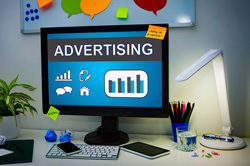By Meaghan Brophy
 Almost 22 years ago, web banner ads revolutionized advertising. Banner ads were one of the first Internet marketing strategies. They allowed businesses to actually keep track of how many consumers viewed and subsequently interacted with the ad. In 1994, this was groundbreaking. However, the Internet and its users have matured quickly, leaving web banner ads essentially obsolete. Customers can no longer be fooled into thinking banner ads are part of the website editorial, with studies showing that most consumers don’t even look at ads, let alone click on them. This phenomenon where consumers completely overlook banner ads is frequently referred to as banner blindness. “Click through rates of banners are going down, and people are talking about banner blindness regularly,” says Manish Patel, CEO of Brandify, an innovative digital marketing provider.
Almost 22 years ago, web banner ads revolutionized advertising. Banner ads were one of the first Internet marketing strategies. They allowed businesses to actually keep track of how many consumers viewed and subsequently interacted with the ad. In 1994, this was groundbreaking. However, the Internet and its users have matured quickly, leaving web banner ads essentially obsolete. Customers can no longer be fooled into thinking banner ads are part of the website editorial, with studies showing that most consumers don’t even look at ads, let alone click on them. This phenomenon where consumers completely overlook banner ads is frequently referred to as banner blindness. “Click through rates of banners are going down, and people are talking about banner blindness regularly,” says Manish Patel, CEO of Brandify, an innovative digital marketing provider.
In the current age of web banner blindness, we are seeing modifications on the traditional banner in attempts to reengage the consumer. Full-page takeovers, popovers, and auto-play videos have all tried to gain the revolutionary impact of the first banner ads. However, “Situational marketing is more in line with what the consumer will engage in opposed to just zapping an irrelevant ad without context,” explains Patel. Patel advocates taking advantage of mobile and geopositional technology to target consumers when they are looking for your company, or in a position to welcome a message from your store. “Enhance yourself and work yourself into the experience with the customer,” says Patel. “For example, have an ad pop up when someone drives by. If a customer is stuck in traffic, send them a message offering a coupon and a new route.” Situational marketing is all about “Using data that’s available and being intelligent about the situation the customers are in. It’s getting the marketing team thinking smarter about the consumer, because consumers are smarter.”
 For independent retailers who might not have access to geopositional technology, or have your own app with notifications, the basic concepts remain the same. “Understanding your audience is important,” says Patel. “70% of our audience is using mobile to find locations.” As a retailer, you need to understand the size of your audience and where they’re coming from. “You have to get your foot in the market,” continues Patel. “There is no silver bullet. You have to try different things to measure the success of what works for you. Just because others are doing Google ad words, doesn’t mean that is best for you.” The advantage of mobile marketing is, like we’ve learned from the traditional banner ad, everything can be tracked. Retailers know when their mobile efforts are being seen, clicked on, and acted upon. “As a business owner, you have to understand response rates and cost per lead metrics. If I have $1,000 to spend, and I get one lead, my cost per lead is $1,000. This type of understanding is what’s driving the phone to ring,” explains Patel. If you’re nervous about changing marketing strategies, or are afraid to walk away from yellow pages, coupons or other traditional channels, try allocating some funds to new technologies to run a comparison, advises Patel. There are simple steps you can take as a business owner to ensure the minimum.
For independent retailers who might not have access to geopositional technology, or have your own app with notifications, the basic concepts remain the same. “Understanding your audience is important,” says Patel. “70% of our audience is using mobile to find locations.” As a retailer, you need to understand the size of your audience and where they’re coming from. “You have to get your foot in the market,” continues Patel. “There is no silver bullet. You have to try different things to measure the success of what works for you. Just because others are doing Google ad words, doesn’t mean that is best for you.” The advantage of mobile marketing is, like we’ve learned from the traditional banner ad, everything can be tracked. Retailers know when their mobile efforts are being seen, clicked on, and acted upon. “As a business owner, you have to understand response rates and cost per lead metrics. If I have $1,000 to spend, and I get one lead, my cost per lead is $1,000. This type of understanding is what’s driving the phone to ring,” explains Patel. If you’re nervous about changing marketing strategies, or are afraid to walk away from yellow pages, coupons or other traditional channels, try allocating some funds to new technologies to run a comparison, advises Patel. There are simple steps you can take as a business owner to ensure the minimum.
As retailers, at the end of the day what really matters is getting the phone to ring and customers to walk through the door. Since 70% of consumers are searching for businesses on mobile, there are easy steps you can take to optimize your position. Make sure your website is mobile optimized (“responsive”) and has the company phone number. Have a complete Facebook business page with up-to-date information. Manage your Yelp reputation. Negative online reviews can be damaging, but a swift, courteous, and helpful response can go a long way in showing customers and potential customers that you care. Customers are “experience loyal, not brand loyal,” says Patel. Do your best to make your company accessible, and have your store’s online experience match your physical one. You may have the most friendly and helpful employees in the area, but if questions and reviews are being neglected online, potential customers who have not visited your store will not get that impression.
In the world of the ever-savvy online consumer, companies can no longer successfully trick or force their banner ads on unwilling consumers. An effective, low-cost approach retailers can take is to have an up-to-date, accessible, and optimized an online presence so that when consumers go searching, they like what they see. Having your phone number, email, and correct hours listed on all platforms, speedy responses to inquiries and reviews, and active listings in appropriate directories help searching consumers find your business when they need it. As Patel advises, “If you’re not in the places they’re looking for, they will go elsewhere.”
